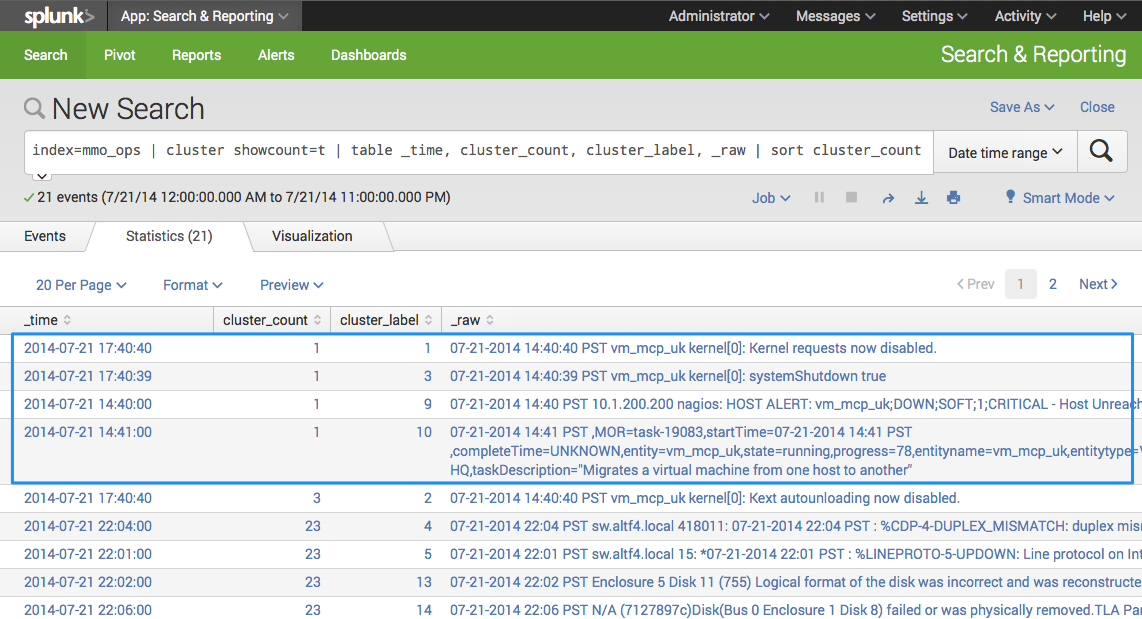#Splunk commands examples how to #Splunk commands examples series Specify a calculation in the where command expression
This example uses both the like function and the cidrmatch function. For example, to specify 30 seconds you can use 30s.
The consists of two parts, an integer and a time scale. Return events that match the IP or is in the specified subnet. With the GROUPBY clause in the from command, the parameter is specified with the in the span function. Match IP addresses or a subnet using the where command The like function supports several syntaxes, see Comparison and Conditional functions.Ģ. In this example, the where command returns search results for values in the ipaddress field that start with 198. A transforming command takes your event data and converts it into an organized results table. The percent ( % ) symbol is the wildcard you must use with the like function.
You can only specify a wildcard with the where command by using the like function. Chart To create a chart out of the search result. In most cases you can use the WHERE clause in the from command instead of using the where command separately. Examples of Transforming Commands Highlight To highlight the specific terms in a result. append, appendcols, join, diff setfields, Sets the field values for all. See Predicate expressions in the SPL2 Search Manual. Splunk Commands set, Performs set operations (union, diff, intersect) on subsearches. The where command expects a predicate expression. Bin the results based on the _time field.Īlign the bins to the UTC time of 1500567890 for values in the _time field. The bins will represent 3am - 3pm, then 3pm - 3am (the next day), and so on. Align the bins to a specific time and set the span to 12 hour intervals from that time Bin the results based on the amount field.Ĥ. Create bins with a large end value to ensure that all possible values are includedĬreate bins with an end value larger than you need to ensure that all possible values are included. | bin bins=10 size AS bin_size | stats count(_raw) BY bin_sizeģ. By default the top command returns the top 10. Use the top command to return the most common port values. You must specify several examples with the erex command. sourcetypesecure port 'failed password' Then use the erex command to extract the port field. Specify a bin size and return the count of raw events for each binīin the search results into 10 bins for the size field and return the count of raw events for each bin. Run a search to find examples of the port values, where there was a failed login attempt. Result: Explanation: As you know in the previous step we uploaded a lookup file name statuscode.csv, by using the inputlookup command we are viewing the content of that lookup file as simply as you see. | stats avg(thruput) by span(_time, 5m), host 2. This is the only required argument in this command.
#Splunk commands examples series Use a to match the regex to a series of numbers and replace the numbers with an anonymized string to preserve privacy. This command is used to extract the fields using regular expressions. Usage of Splunk Rex command is as follows : Rex command in splunk is used for field extraction in the search head. To learn more about the rex command, see How the rex command works. This topic is going to explain to you the Rex command in Splunk with lots of interesting Splunk Rex examples. See Initiating subsearches with search commands in the Splunk Cloud Platform Search Manual. A subsearch can be initiated through a search command such as the search command. | bin span=5m _time | stats avg(thruput) by _time, hostĪlternative: You can also specify the span directly with the stats command. The following are examples for using the SPL2 rex command. When the search command is used further down the pipeline, it is a distributable streaming command. To learn more about the search command, see How the search command works. Return the average "thruput" of each "host" for each 5 minute time span. The following are examples for using the SPL2 search command. Why are the time modifiers not working for union c.
#Splunk commands examples how to How to debug the sum.py sdk example command from t. Return the average for a field for a specific time spanīin the search results using a 5 minute time span on the _time field. Any example for MAP command bin and bucket command examples to practice Can someone provide the most simple example possib. To learn more about the bin command, see How the bin command works.ġ. The following are examples for using the SPL2 bin command.





